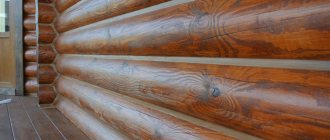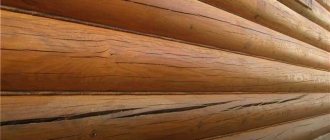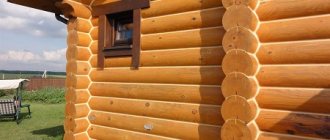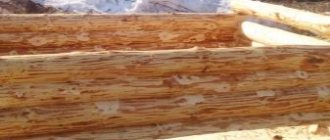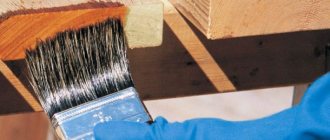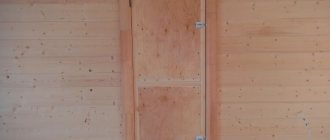Greetings to one and all! It is fair to admit that wood is a very beautiful, natural, but not strong enough material. It needs careful care. From time to time it is necessary to use products to seal cracks, treat defects and seams. This is where exterior wood putty comes to the rescue.
To minimize damage to wood, you need putty specifically for work carried out outside. It differs from its interior counterpart because it has fewer requirements.
The only question is which facade putty will be better.
The advantage of using wood putty to remove defects and cracks
Wood putty is used for a variety of products, in everyday life these are: window frames, floors, wooden openings, baseboards, plywood, parquet, etc.
When puttying surfaces, the following advantages :
- wood putty for exterior use prevents moisture from entering the recesses of wooden products and damaging them. Thanks to this, the service life increases several times;
- wood putty for filling cracks allows you to eliminate various defects on the surface;
- you can purchase putty that has no color, then after hardening it will be colorless and the natural texture of the material will not deteriorate ;
- the material for a wooden floor adheres tightly to the surface and fills all possible imperfections, which prevents the ingress of dirt and other unwanted particles.
There is only one factor that is a contraindication to the use of putty - if the wood is exposed to frequent wetness, the mixture will simply crack and fall off.
The putty provides resistance to moisture, but if there are puddles on the surface or condensation forms, the coating will not last long.
When choosing wood putty, not only price is important, but also some other factors, which we will consider further.
The best putty for wood
Woodworking using this product means processing a wide variety of surfaces.
These include old cracked frames, new doors made from solid wood of different species, fashionable new parquet or cracking old parquet, and much more.
To perform any construction task, the choice of this tool is determined by the many qualities that it possesses:
- A wooden surface treated with it stops absorbing moisture, therefore, parts and elements made from it will be healthy and dry, and will last quite a long time;
- The mixture is able to smooth out all defects, cracks and knots, which are very characteristic of natural wood;
- When dry, the applied coating may become transparent or acquire the texture of the surface being treated. After using putty, all wooden elements can be painted or finished with decorative varnish;
- The parquet product perfectly connects to the floor and levels it, filling all the holes and irregularities that appear on the wood over time.
Main factors for choosing putty
The selection criteria are quite multifaceted, but the main ones are:
- maximum level of adhesion (the property indicates the ability of the putty to adhere to the surface); elasticity is important during application. The softer and more flexible the material, the easier it is to work with. After hardening, this affects the integrity of the coating and its resistance to cracking;
- period for acquiring maximum strength;
- environmental friendliness of raw materials. Some chemical components can release toxins; this should be avoided even at the stage of choosing a material for the floor, because the well-being of the buyer may depend on which one the buyer chooses;
- the finishing putty must have a fine grain fraction to ensure a perfectly even structure.
It is not only the type of material used that matters, but the method of application. Almost all types of finishing, be it wallpapering, varnishing or painting, require the wood to be perfectly even, so the mixture must be applied in neat, thin layers.
How to choose?
After puttying, the treated surface should look neat. If there are thin grooves, irregularities, dried grains, etc., then the varnish or paint applied on top will “accept” and “reveal” these defects on its surface. This point should not be forgotten. Here are the criteria for quality putty:
- Strong adhesion. It doesn’t matter what it is: pure wood, varnish, paint or other surface;
- Not a significant drying period;
- Plasticity (easy and convenient to work);
- When using a dry mixture, small particles make it possible to make the finishing layer thin but durable;
- Environmentally safe for health.
Before applying, check the color and texture on a small, inconspicuous area. Wait until dry and sand. If you are satisfied with the result, proceed to the main work.
Varieties
There are different types of wood putties, mainly they differ in the type of base. Depending on the material on which the mixture is made, the putty acquires characteristic properties . There are these types of mixtures.
Plaster
This putty is quite popular because it has a high level of elasticity, excellent adhesion and is resistant to steam penetration.
The main disadvantage is that gypsum does not tolerate water well, so it is not used in rooms with high humidity levels or for facade work.
Acrylic for filling cracks with your own hands
Acrylic for wood is quite elastic and very pliable and has a number of advantages. If you need colored putty for wood, then the abundance of shades is great for the acrylic type. It is considered the best way to eliminate cracks in parquet flooring.
Acrylic
The only drawback is its high price, although sometimes you will have to renew the coating or cover it with insulation on top. But it can be used for almost all types of surfaces, also suitable for outdoor use.
Latex
Latex is quite expensive, but it dries quickly and allows you to create a smooth surface.
Latex
The composition of the existing wood putty is very safe and does not provoke harmful divisions. Most often used to repair holes in parquet floors.
Polymer Nitro
This is a polymer for wood for interior use, which consists of solvents, resins from oil production and plasticizers.
The advantage of this variety is that it is very resistant to chemicals, has excellent shrinkage resistance and is quite elastic, which makes it easy to sand. The mixture has a specific odor, but after hardening it evaporates.
Oil moisture resistant
Oil putty for petria wood basically contains chalk, varnish and drying oil.
Thanks to the presence of drying oil, wood putty is moisture-resistant, so it is often used for processing facade wooden products, especially windows and window frames.
Oily
This results in a highly durable coating. It also provides resistance to bacterial damage, that is, fungus, pests, and mold will not destroy the tree. The only drawback is that the mixture takes a long time to dry.
Adhesive
It is based on ordinary PVA glue; this mixture is prepared immediately before application.
PVA
Epoxy thermal and moisture resistant for outdoor use
This variety is relevant for use in areas with large temperature changes.
Epoxy putty for wood is resistant to different temperatures. Provides protection from moisture and is not destroyed by exposure to the sun.
Resistant to aggressive chemical elements: detergents and mineral-based oils. Finishing wood putty is excellent for exterior work, as it is heat and moisture resistant. Here is the consumption per 1 m2.
Epoxy
Each presented category has certain qualities that determine the areas of their use. In addition to classification, there are mixtures of different qualities, depending on the manufacturer.
Waterproof putty for wood
Water-based putties are considered safe for human health. Water is used as an active substance, which allows the active components to penetrate into the deep layers of wood. To work with this type of material you do not need any skills or experience.
The plastic mass quickly fills visible defects. You can remove excess mixture with a damp cloth. This does not require the use of acetone and turpentine-based liquid.
The disadvantage of such products is that they dry quickly. If the seal of the container is broken, it is recommended to quickly use up the mixture. Such compositions have a high level of adhesion. There are a number of advantages of water-based wood putty.
These include:
- Efficiency. This mixture can be used to level various surfaces decorated with wood. Thanks to the plastic texture, it is possible to get rid of joints in the area of the floorboards;
- Environmentally friendly composition. After drying, wood putty does not release toxic impurities into the air. When the temperature changes in the air, the absence of chemical components is noted;
- Moisture resistance. Wood treatment mixtures are designed for various climatic disasters. That is why putty is chosen for interior and exterior finishing;
- Long-term operation. The composition of wood putty consists of polymer compounds, which after crystallization form a dense shell. It does not deform under the influence of mechanical and physical force;
- Elastic structure. Thanks to proper use, the wood finishing product can be given any shape.
All these advantages are manifested when the putty composition is properly dried. The optimal level of humidity and temperature conditions not exceeding 20 degrees will allow the polymerization process to be accelerated.
Manufacturers of mixtures and types of materials - how to choose the best putty
Most hardware stores have at least several varieties of putty, and most often there is a whole range of choices. There are putties for wood for painting, for varnishing, for leveling, etc.
Manufacturers also differ, there are domestic options, most often they have a low price, as well as foreign ones.
Among foreign manufacturers, the most famous is Tikkurila wood putty, as it does an excellent job of creating a flat surface and preparing for further processing.
The company’s advantage is that the product range includes not only white wood putty. More often, various pigments are added to ensure maximum similarity between the color and type of wood, so that the mixture does not stand out and spoil the appearance.
At the same time, the climate zone does not play a role when using Tikkurila wood putty, whether in Moscow or Siberia.
Also quite popular manufacturers are:
Lakra
Excellent for parquet.
Lakra
VGT
For wood, it is best suited for preparing the surface for painting. In this case, there is vgt extra wood putty, which has the best adhesion and resistance to external influences.
vgt
Eurotex
Fairly cheap and high-quality wood putty Tex can be used in most applications.
Eurotex
Extra
Allows you to eliminate even minor cracks and surface unevenness.
Extra
Rainbow
The main advantages are that it dries quickly and has a high adhesion rate. Here we talk about how long it takes for the putty to dry.
Parade
Parade wood putty has an excellent level of plasticity, flexibility in processing, and resistance to water. It is also resistant to shrinkage and cracking.
Parade
Smes
The little-known Smes wood putty can surprise you with its high quality products.
Leroy Merlin wood putty is quite well known, but it is not a manufacturing company, but only an intermediary with many products in its assortment.
Leading manufacturers
Various manufacturers, both domestic and foreign, produce wood putties.
"Lakra"
A mixture based on acrylic water dispersion. In appearance it resembles different shades of untreated wood (available in several tones - walnut, mahogany, oak, pine and others). It has a fine-grained texture, is flexible, easy to apply and sands well, and can then be painted. Widely used for filling cracks, leveling chips and other defects, recommended for puttying parquet.
VGT
Fine putty paste for covering knots, cracks, and other types of finishing work on wood. It is equally well suited for processing MDF, chipboard, fiberboard, as well as concrete and brick. Made on the basis of a polymer water dispersion, pigments, fillers and modifying additives. Can be used as a finishing putty in places with high humidity and even where it will periodically come into contact with water.
"Extra Profilux"
Well suited for sealing irregularities, knots, cracks on furniture, windows, walls. Made on the basis of special polymers and functional additives, if necessary, can be diluted with water. The mixture is fire- and explosion-proof, environmentally friendly, and has high adhesion to wooden surfaces. It is applied in a layer of up to 1 mm, but after drying it can be reapplied (for example, when repairing deep chips).
"Rainbow"
Elastic putty mixture is characterized by high resistance to deformation and cracking. It has a minimal degree of shrinkage and can seal any seams in wood. Reliably adheres to lumber and other types of wood raw materials. With a layer thickness of 1 mm, it dries in just 4 hours, and after that it can be sanded or otherwise machined. Does not deteriorate from moisture or ultraviolet radiation, ideal for outdoor use.
Superplastic acrylic mixture Rainbow
"Bolars"
Finishing putty paste with high moisture resistance. After drying, it acquires greater compressive strength. Can be used in a temperature range of -40...+60 degrees, withstands frost well. Withstands up to 50 freezing and thawing cycles.
Parade
Moisture-resistant putty, quickly masks all defects on the wood surface, well suited for external and internal work, as well as for sealing parquet defects. It is economical in consumption, very durable, and boasts an affordable price. Each layer, 1 mm thick, dries for about 4 hours, then must be sanded, and then painted or varnished.
Smes
A two-component wood putty designed for filling cracks and gouges in beams in order to restore aesthetics and a normal level of thermal insulation. Also suitable for improving the appearance and protection of boards, lining, plywood, and is no less suitable for work on gypsum plasterboards. Used for exterior and interior decoration. Can be applied for the purpose of repairing and gluing furniture.
"Tikkurila"
The composition has a water-repellent effect and can itself be diluted with water. It recreates the structure of the wood of the most popular species - pine, beech, oak, birch and others. Widely used for working with ceiling and wall panels, doors, furniture. A 2 mm layer does not crack after drying, and it can simply be sanded and not even painted, although the application of paints or stains is acceptable.
Belinka
A series of colored wood putties (6 shades), ideal for external and internal structures, furniture, and finishing materials. It is a one-component dispersion polymer composition that quickly and efficiently eliminates all cracks and irregularities. It is characterized by high plasticity and filling ability; it can be applied with a spatula without any problems. Each layer of material dries in no more than 4 hours, and initial setting occurs in 20 minutes.
Eurotex
Composition based on acrylic modified copolymers. Used for repairing chips and other defects on wooden substrates. After drying, it allows the application of water-dispersed coatings or products based on organic solvents. Easy to paint and sand, can be used as a finishing material. It has high moisture resistance, is universal, suitable for old and new substrates. Requires high-quality surface preparation before application.
Evrotex for wood
Color
It is necessary to choose the right putty color, as there are options that are not at all suitable for certain types of work.
For example, if you plan to open the wood with varnish, you cannot seal cracks in the texture using white or black wood putty, otherwise the treated areas will be very noticeable and the aesthetic appearance will be lost. But when painting the surface, it does not matter what color the mixture will be.
It is best to choose a material that is similar in color to the color of wood.
So, wenge wood putty is quite suitable for oak, but for light varieties it will look awkward.
Why were so many of its types invented?
There are different types of wood putty, and there is plenty to choose from. It is important not to get confused and buy the best one. You can accidentally apply it incorrectly, make a mistake if you don’t have the skill, or a diploma in acquiring a construction specialty. Errors will have to be eliminated, which means additional deformation of the original structure.
If the putty is not particularly suitable, after a few months you will have to start working again. This cannot continue for long, of course. Wooden elements will soon simply become unusable.
Furniture restoration, repairs, and decor creation is a creative process. An amateur should be able to cope with the task. Manufacturers, of course, take this into account when creating finishing materials. The work will progress, the result will be wonderful.
Correcting defects will not be difficult, the wood will not be damaged if you spend a little more time shopping, study the options that are on sale, new items and long-familiar items. Which wood putty is best? This will tell you the composition, properties, characteristics.
How to make it yourself - recipes for homemade wood material
It's time to consider how to quickly and effectively make wood putty with your own hands, because you don't always have the opportunity or desire to go to the store. Here is its consumption per 1 m2 of wall.
Note that it will not be possible to achieve the same quality of the product, but it will be sufficient to perform most types of work. The most common and famous DIY wood putty recipes.
For more information about homemade putty, watch the video:
PVA and chalk
This is the best option for making wood putty as simply and quickly as possible.
Chalk
It is made in just a few steps: grind the chalk and add glue to it. Mix all this until you get a homogeneous consistency, something similar to the thickness of fat sour cream.
If the seams that need to be sealed are large, you can add a little small sawdust.
PVA
Duration of hardening is 24 hours.
Elastic mixture - water-soluble varnish and furniture chalk
In terms of price, the mixture will be cheaper, and the only difference is that instead of PVA, water-soluble varnish will be used.
Due to its high elasticity and strength, wood putty can be used for furniture, door and window openings.
Mainly used for particle boards.
Water-soluble varnish
In this case, you can add color to the mixture and dilute it well to get a color similar to the surface. Here's how to breed.
To get a complete solution, it is better to mix it in the evening, then it will be ready in the morning. If necessary, you can dilute it a little with water. You can add a little sawdust.
Sawdust
The mixture dries within 12 hours after application. Thanks to the low price and wide range of color choices, you can create designs, such as putty trees on the wall.
Sawdust, chalk and nitro varnish
This homemade wood putty can only be used in non-residential premises or in the manufacture of facades, since the smell is very pungent and it does not completely disappear after drying.
Nitrolac
Do-it-yourself wood putty is prepared identically to previous methods.
Two-component putty, which includes oil and drying oil
The result is a two-component wood putty consisting of: linseed (280 g), turpentine (60 g) oils, as well as pumice powder (30 g), casein and gelatin (20 g each), an ammonia solution with a concentration of 18% (18 g) and borax (12 g). The manufacturing process is somewhat more complicated than previous options:
- mix the oil with pumice;
- add 300 g of water;
- we gradually include other components;
- bring the mixture to 90°C in a water bath;
- mix everything very thoroughly;
- readiness is indicated by the acquisition of toothpaste consistency;
- Allow the mixture to cool slightly;
- it is necessary to use the prepared wood putty until it loses its working properties - this period lasts 1 hour.
To understand more clearly the resulting consistency and method of preparation, you can watch a video on how to prepare wood putty with your own hands.
Purpose and application
The main task of putty is to restore the integrity of wooden structures. Using this tool, several issues can be easily resolved at once:
- sealing gaps and cracks in the wood structure, joints and seams when connecting two wooden elements, as well as leveling the surface topography;
- creating a protective layer that will be a powerful barrier to moisture and contaminants trying to penetrate the material;
- increasing the wear resistance of wooden structures and preventing the occurrence of rotting processes and the formation of fungus on the surface;
- makes it possible to create a single shade for subsequent painting of the product;
- restoration of the appearance of old materials, after which they look like new;
- improves adhesion when applying decorative elements.
All that is needed from the putty is to create a horizontal layer for subsequent decorative work. Otherwise, the result will not meet the owner’s requirements. In order for construction work to be carried out efficiently, it is necessary to choose the right means, which must meet the following requirements:
- the putty must contain plasticizers;
- the mixture should ensure good adhesion of materials;
- absence of toxic and harmful components that adversely affect the human body;
- dry quickly for further processing.
Wood putty is presented as a ready-made mixture and does not need to be diluted with water, as dry putty materials require. It is widely used for processing wooden structures of the Soviet period, as well as completely new products, restoring old parquet and other surfaces.
conclusions
Initially, you need to prepare the workplace, cover everything with oilcloth, stick on scratch tape, and cover it with newspapers so as not to cover the good surface. Next, put on gloves, safety glasses, and use a respirator if necessary.
Putty should be applied to a clean surface , any remaining paint, putty, plaster and other undesirable substances. It is necessary to remove the metal parts so that they do not corrode and the red color does not appear. Next, prime everything.
Now is the time to use wood putty in tubes or special containers. It is applied in a thin layer using an iron or rubber spatula. The layer thickness should not exceed 2-3 mm.
Algorithm for using putty
If, for example, putty is used for a board floor, then the work must be performed in the following order:
- Only prepared surfaces can be puttied. If local defects are being repaired, then it is necessary to run a grinding machine over the area next to the crack or chip. The inside of the defective object can be cleaned with a simple knife or other sharp object;
- if in the future you plan to replace the existing floor covering, then, first of all, it is necessary to examine the flooring for rotten and poorly secured boards. Then they are replaced, the surface is ground and sanded. Very deep cracks must be cleaned;
- After preparing the surface itself, it is necessary to eliminate existing deep defects. Any cavities must be filled. However, starting putty is usually used for these purposes. If work is carried out with the finishing composition, then it is not advisable to prepare two mixtures and spend money on their purchase. It would be more practical to use twine or rope of suitable sizes. The element is impregnated with an adhesive mixture and pushed into the crack using a screwdriver. After the mixture dries, you will get an almost uniform coating, ready for processing; the putty process itself is carried out using a rubber spatula. The applied composition dries in about a day, but if defective areas with a deep structure were eliminated, then you should wait 2-3 days.
It is necessary to take into account the size of the room in which the work is being carried out and mix the putty mixture in such an amount that it is enough for one session of work, since such compositions have a certain shelf life.
You can give a woody tint to our putty by adding certain additives to the composition. The cheapest way to prepare the composition yourself is gouache or ocher.
Workflow Description
We will divide all the work into two stages - preparing and applying putty for wood. Each stage is important in its own way, so you should follow all the recommendations below to achieve the best result.
Preparation
As part of this part of the work, the following activities are carried out:
- First of all, it is necessary to remove remnants of old paint from the surface if any, especially for external structures that are exposed to adverse influences, which is why the paint layer is most often not in the best condition. The easiest way to carry out the work is with a block onto which a sheet of sandpaper with P100 or P80 grit is attached.

